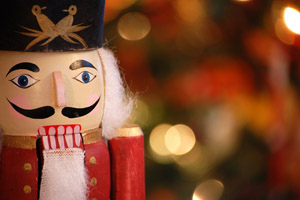
Nutcrackers
The German style nutcrackers have huge garish teeth and the usual pair of staring, eyes. These nutcrackers are whimsical and some comical. They are a collectible that can be displayed the year round, not only during the Christmas Holidays. Everyone is familiar with the nutcracker and usually it is depicted as a soldier. These wonderful nutcrackers depict several holidays and all walks of life.
The Nutcracker began in the villages of the Erzgebirge region of Germany in the Ore mountains, near the Bohemian Border. The Ore Mountains were rich in minerals and many of the locals worked in the mines. During the winter months, the miners would carve to pass the time. Usually they would carve Christmas presents and toys. A favorite carving was the toy soldier. Naturally the first nutcrackers were soldiers. In the 1700's the lathe was invented. The miners would use a lathe driven by the power of running water. The lathe would carve the pieces of the nutcracker, which would be assembled and painted. At one time as many as 30 lathes operated in the Erzgebirge region.
As the mines ran out of ore, the miners began to make toys, presents and nutcrackers full time. Soon vendors were selling the Erzgebirge items all over Europe. The nutcracker became a symbol of the region. Two great nutcracker companies survived from the area. Steinbach and Christian Ulbrecht. Their nutcrackers are famous worldwide by collectors, and they command premium prices from collectors. After World War II both companies moved operations to West Germany.
Mistletoe
Today, kissing under the mistletoe is a popular Christmas custom. However, mistletoe was for many centuries a symbol of healing and divine love representing Christ as the Divine Healer of all people and nations. Gradually, mistletoe was introduced into the home, where the more familiar traditions surrounding the plant developed. Hanging mistletoe in a doorway or from the ceiling became a sign of good will and harmony to all visitors ... a throwback to mistletoe's ancient role as a "plant of peace."
Poinsettia
The poinsettia, a traditional Christmas flower, originally grew in Mexico. In Mexico, the poinsettia is known as the 'Flower of the Holy Night'. It was first brought to America by Joel Poinsett in 1829. Read more in our Seasons section.
Christmas Door Wreath
A modern Christmas custom borrowed from ancient Rome's New Year's celebrations is displaying a wreath on the front door of one's house. Romans wished each other "good health" by exchanging branches of evergreens. They called these gifts strenae after Strenia, the goddess of health. It became the custom to bend these into a ring and display them on doorways.
Christmas Tree
The tradition of erecting a tree at Christmas is believed to have started in Germany. Christmas trees are known to have been popular in Germany as far back as the sixteenth century. In England, they became popular after Queen Victoria's husband Albert, who came from Germany, made a tree part of the celebrations at Windsor Castle. In North America, the earliest known mention of a Christmas tree is in the diary of a German who settled in Pennsylvania.
Christmas Crackers
Tom Smith, an English confectioner, invented the Christmas cracker in 1847, drawing his inspiration from packaged French sweets, or bon-bons. The original crackers were much like those of today, but the name was different. Smith called his crackers by the French word for Cossacks. The snap of the cracker reminded Smith of a cracking whip, and so of the famed Cossack mounted soldiers of Russia. His original crackers, or cosaques, contained a sweet and a "love motto". The company he founded exists to this day, and supplies Christmas crackers to the British royal family.
The real St. Nicholas lived in Turkey. St. Nicholas was bishop of the Turkish town of Myra in the early 4th century. It was the Dutch who first made him into a Christmas gift-giver, and Dutch settlers brought him to America where his name eventually became the familiar Santa Claus.
Christmas Stockings
The custom of hanging out stockings or setting out shoes in the hope of receiving Christmas gifts is said to have begun with St. Nicholas supplying the gold for a dowry. When St. Nicholas was the Bishop of Myra, he knew a poor family with three daughters. As each girl came of age, St. Nicholas provided her dowry by secretly throwing a bag of gold into the house. Some say the gold was dropped down the chimney and fell into a stocking hanging there to dry. Some say the gold fell into a shoe.